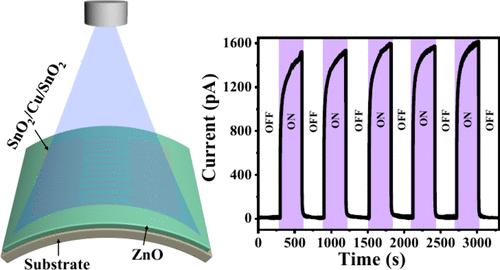Ultrathin Oxide/Metal/Oxide Trilayer Transparent Conducting Electrodes for an All-Transparent Flexible UV Photodetecting Device
IF 4.3
3区 材料科学
Q1 ENGINEERING, ELECTRICAL & ELECTRONIC
引用次数: 0
Abstract
Amidst the rapid advancement of flexible and transparent optoelectronic devices, the oxide/metal/oxide (O/M/O) trilayer structure has been considered to be a potential transparent conducting electrode (TCE) because of its superior stability and better durability as compared to single-layered TCEs or metallic films. In this study, we report an ultrathin sputter-deposited SnO2/Cu/SnO2 trilayer TCE with excellent electrical and optical properties appropriate for flexible and transparent optoelectronic devices. All of the deposited TCE films are almost amorphous in nature with an excellent smooth surface texture, as evident from the X-ray diffraction and atomic force microscopy studies. The X-ray photoelectron spectroscopy study reveals that Cu remains in the elemental state, sandwiched between two oxide layers. The lowest resistivity value of 1.59 × 10–4 Ω·cm along with the highest figure of merit value of around 1.37 × 10–3 Ω–1 have been obtained for a 23 nm (10/3/10) trilayer. The enhanced conductivity in the films primarily results from carrier injection from the Cu layer to the oxide layer. A ZnO-based flexible and all-transparent ultraviolet photodetecting device on polyethylene terephthalate substrates featuring optimized O/M/O (10/3/10) electrodes achieves responsivity and detectivity values of 0.33 mA/W and 3.06 × 1010 Jones, respectively. The device shows a remarkably stable photoresponse under flat as well as various bend conditions. Therefore, this study provides potential ways for fabricating high-quality O/M/O TCEs across a broader spectrum of flexible and transparent optoelectronic devices.

用于全透明柔性紫外光检测设备的超薄氧化物/金属/氧化物三层透明导电电极
随着柔性透明光电器件的快速发展,氧化物/金属/氧化物(O/M/O)三层结构被认为是一种潜在的透明导电电极(TCE),因为与单层 TCE 或金属膜相比,它具有更高的稳定性和更好的耐久性。在这项研究中,我们报告了一种超薄溅射沉积 SnO2/Cu/SnO2 三层 TCE,它具有适合柔性透明光电器件的优异电气和光学特性。从 X 射线衍射和原子力显微镜研究中可以看出,所有沉积的 TCE 薄膜几乎都是无定形的,表面纹理非常光滑。X 射线光电子能谱研究表明,铜仍处于元素状态,夹在两层氧化物之间。23 纳米(10/3/10)三层薄膜的电阻率最低,为 1.59 × 10-4 Ω-cm,优点值最高,约为 1.37 × 10-3 Ω-1。薄膜导电性的增强主要是由于载流子从铜层注入到氧化物层。在聚对苯二甲酸乙二醇酯基底上,一种基于氧化锌的柔性全透明紫外光检测器件采用了优化的 O/M/O(10/3/10)电极,其响应度和检测度分别达到了 0.33 mA/W 和 3.06 × 1010 Jones。该器件在平坦和各种弯曲条件下都显示出非常稳定的光响应。因此,这项研究为在更广泛的柔性透明光电器件中制造高质量的 O/M/O TCE 提供了潜在的途径。
本文章由计算机程序翻译,如有差异,请以英文原文为准。
求助全文
约1分钟内获得全文
求助全文
来源期刊

ACS Applied Electronic Materials
Multiple-
CiteScore
7.20
自引率
4.30%
发文量
567
期刊介绍:
ACS Applied Electronic Materials is an interdisciplinary journal publishing original research covering all aspects of electronic materials. The journal is devoted to reports of new and original experimental and theoretical research of an applied nature that integrate knowledge in the areas of materials science, engineering, optics, physics, and chemistry into important applications of electronic materials. Sample research topics that span the journal's scope are inorganic, organic, ionic and polymeric materials with properties that include conducting, semiconducting, superconducting, insulating, dielectric, magnetic, optoelectronic, piezoelectric, ferroelectric and thermoelectric.
Indexed/Abstracted:
Web of Science SCIE
Scopus
CAS
INSPEC
Portico
 求助内容:
求助内容: 应助结果提醒方式:
应助结果提醒方式:


